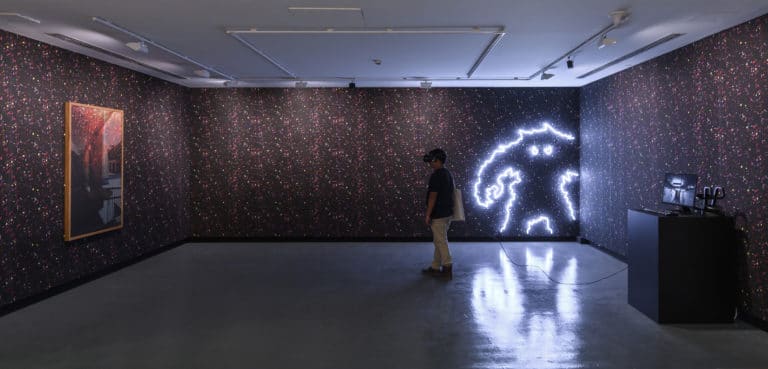Our Head of Arts, Chelsea Pettitt, recently sat down with artist Shezad Dawood to discuss his new work Encroachments which premiered at Sharjah Biennial and which the Foundation supported. Full details about the work and the Biennial can be found here.
Chelsea Pettitt: Upon viewing the installation and Virtual Reality (VR) for Encroachments at the Sharjah Biennial, and being led by a well-briefed gallery invigilator, it struck me that there were so many layers which fed into this work. From the central theme of Richard Neutra’s ‘failed’ US embassy building in Karachi to 1960s music in Pakistan, to terrazzo flooring and to the detail of the bookstore in Lahore. I was hoping that we could unpack these a little bit. How did all of these start to come together for you? Were some of these references to personal memories? Or did one lead to another purely through research?
Shezad Dawood: In some ways this is one of my most personal projects yet, where I found myself blending the density of the references with more personal visceral associations. Neutra’s embassy, which was downgraded to a consulate, had something called The American Center, where kids could go and immerse themselves in American pop culture, specifically comic books in my case. And at the same point in my childhood I was also frequenting the pop-up video game arcades that had been emerging in the Saddar district. So these two poles of Americana, were really axiomatic of the portion of my childhood spent in Karachi. And it was only later that I began to consider their propaganda function and timing in relation to the Soviet invasion of neighbouring Afghanistan. And this became the point of departure for the project.
CP: In the press release, you describe ‘encroachments’ as a reference to the backlash against ‘illegal structures’ and the grey area between public and private land ownership. Although you make a point of saying its related to Karachi and Lahore, the politics of space also translates across to cities such as London, where you are based; even my local town in Kent where the council is selling off a precious piece of green space to private developers; and of course settlements built along the Israel/Palestine border. Can you speak a little about the specifics of the encroachments you mention in relation to Lahore and Karachi and their wider implications?
SD: I’m very interested in the grass-roots entrepreneurialism that contemporary Encroachments represent in Pakistan, and how they play with the politics of space in a very nimble and adaptable way. And I was interested in how this could be extrapolated to think about ‘The Commons’ more generally. Not solely in terms of physical land grabs, such as ‘privately owned public spaces’ or ‘Pops’ in London, where seemingly public spaces are patrolled by private security who can prevent people taking photographs or journalists attempting to talk to people, but also in terms of the encroachment of psychological space that is embodied by dominant ideologies and advertising. And of course the visceral and troubling presence of borders, which are always haunted by those who drew them.
CP: Being known as a painter to some, and as a filmmaker to others, where does VR sit within your practice? I mean from a creative standpoint and from a development perspective. The installation was a nice example of how it all comes together formally and I understand you are hoping to add sculpture to it once it tours to New Art Exchange, Nottingham in 2020.
SD: I always felt my paintings were born of an editing process, similar to the way I cut up my films. And after years of making and talking about immersive cinema and the active participation of the viewer, some friends who were quite radical developers and coders, began persuading me to look at VR as a natural extension of some of the things I’d been talking about for some time. And after some years of experimentation I released my first VR work: Kalimpong, in 2016. But what was important to me, as in all my work, was a philosophical set of questions relating to narrative and embodiment. Which is also why my paintings always play along a line between figuration and abstraction – because neither extreme really exists. I quite like using the space of the exhibition as a larger artwork or container that can hold diverse elements within it. And yes sculpture will be present at New Art Exchange too, as within the expanded space of a solo presentation you can take things a little further.
CP: There was an exciting and unexpected point within the VR where the viewer ends up enveloped by the Space Invaders game, before we end up watching archival footage projections on the US Embassy building. The final scene was also a bit of a surprise. Without giving away too much, can you talk a little about who you worked with and how you achieved such layered and differing perspectives and experiences for the viewer?
SD: I had brainstormed the whole sequence or storyboard with a number of people I trust, and I always like finding ways to surprise and delight an audience with something unexpected, so for me the section of the Embassy was a particular highlight. The films rather than being archival, are film material I shot, largely on Super 8, of the interior of the Embassy, projected onto the exterior of the digitally rendered Embassy in VR – I love frustrating the binaries that people would like to apply to, say VR versus analogue film, and instead putting them into an intimate conversation with one another.
CP: I loved the prints that were on the walls. One depicted an arcade game and another, the building from the VR environment. Can you tell me more about the band poster? Who are they? These, coupled with the Space Invaders game and terrazzo walls almost felt like a young man’s bedroom circa early 80s. Is this what you were going for as an overall feeling for the installation?
SD: The band poster depicts The Panthers, one of Pakistan’s foremost ‘beat’ bands of the late 1960s. The musicians who made up the group, were both Muslim and Christian, and this largely forgotten moment of more mixed communities and musical styles that fused classical Indian ragas with the production values of Brian Wilson, reflects a very different Pakistan that might have been…..The terrazzo by contrast refers to cheap terrazzo that was developed for export, and when it failed became ubiquitous in Pakistan, including in the seedy, smoke-filled video game arcades of the 80s. I flipped this onto the walls, as a fluorescent retouched wallpaper, which was another way to play with the shifting planes of the VR, and the play between interior and exterior, and embodiment and disembodiment that I wanted the whole project to convey.
The Sharjah Biennial, Leaving the Echo Chamber, continues until 10 June 2019. Encroachments will tour to New Art Exchange, Nottingham in January 2020.


